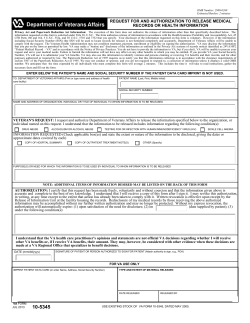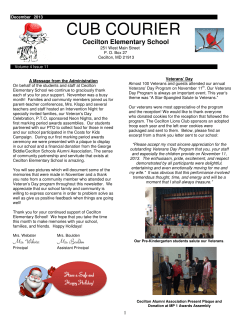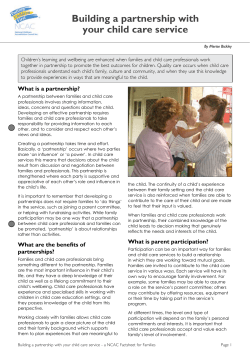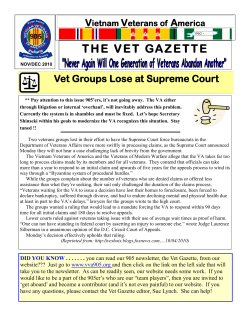
Chapter 3 PARTNERSHIPS AND MEMORANDA OF AGREEMENT/UNDERSTANDING Introduction
M28R, Part I, Section A, Chapter 3 August 1, 2012 Chapter 3 PARTNERSHIPS AND MEMORANDA OF AGREEMENT/UNDERSTANDING 3.01 Introduction 3.02 References and Resources 3.03 Partnerships a. Definition of Partnerships b. Partnerships and Vocational Rehabilitation and Employment (VR&E) 1. Partnerships within Department of Veterans Affairs (VA) Regional Business Lines 2. Partnerships with Other VA Departments 3. Partnerships with Other Federal, State, and Local Agencies 4. Partnerships with National Service Organizations 5. Partnerships with the Private Sector 6. Partnerships with Faith-based/Non-profit/Community Initiative Agencies 3.04 Memorandum of Understanding/Memorandum of Agreement (MOU/MOA) a. Definition of an MOU/MOA b. Development of an MOU/MOA 1. Parties 2. Authority 3. Purpose 4. Responsibilities 5. Reporting and Documentation 6. Points of Contact 7. Modification 8. Effective Date 9. Termination Appendix K. National signed MOUs 3-i M28R, Part I, Section A, Chapter 3 August 1, 2012 Chapter 3 PARTNERSHIPS AND MEMORANDA OF AGREEMENT/UNDERSTANDING 3.01 Introduction Vocational Rehabilitation and Employment (VR&E) believes partnerships with other organizations strengthen VR&E’s ability to provide quality and timely training and employment services to Veterans with disabilities. This chapter covers the definition of partnership, Memorandum of Agreement (MOA) and Memorandum of Understanding (MOU); provides examples of partnerships with other Department of Veteran Affairs (VA) elements and agencies outside the VA, and discusses the importance of partnerships with private sector and faith-based, non-profit and community-based organizations. This chapter also contains the statutory and regulatory provisions covering subject matter related to partnerships, MOA and MOU. 3.02 3.03 References and Resources Laws: 31 United States Code (U.S.C.) 1341 38 U.S.C. 3115 38 U.S.C. 3116 Websites: www.vetsuccess.gov/partners www.dav.org www.aaptsdassn.org www.vfw.org Partnerships a. Definition of Partnerships Partnerships are established relationships that involve close cooperation between individuals or entities that have overarching goals and missions. b. Partnerships and VR&E 1. Partnerships within VA Regional Business Lines Establishing relationships within Veterans Benefits Administration (VBA) strengthens the network of services and resources available to the Veterans we serve. VR&E staff should work closely to develop partnerships within their Regional Office (RO) and within VBA. There are many examples of ways in which Veterans Affairs RO (VARO) business lines partner together. For example, VR&E and Loan Guaranty (LGY) 3-1 M28R, Part I, Section A, Chapter 3 August 1, 2012 partner on cases in which a Veteran participating in an Individualized Independent Living Plan (IILP) requires home modification (in the form of a construction project) in order to increase his/her independence and to be able to live in a safer home environment. Another example is how RO divisions often use VR&E as a recruitment source to obtain candidates for filling job vacancies. 2. Partnerships with Other VA Departments VR&E works cooperatively with other VA departments to meet Veterans’ health needs, obtain information that may impact rehabilitation planning or program participation and provide services to facilitate successful program completion. Examples of partnerships between VR&E and departments in the Veterans Health Administration (VHA) include the following: VR&E counselors refer Veterans to the VA Medical Center (VAMC) for healthcare and treatment and to the Vet Center/Readjustment Counseling Service, where they can receive assistance/counseling on adjusting to civilian life. In addition, women Veterans are referred to Women Veterans Health Care services, which could be particularly important to women Veterans seeking gender-specific health care. VR&E Veterans with low vision or blindness are referred to Blind Rehabilitation Services’ Visual Impairment Services Team (VIST) for information on how to improve their vision so that they can succeed in their VR&E plan, or receive low-vision aids and training to help them function more independently in their homes and community. Veterans with a Traumatic Brain Injury (TBI) or suspected TBI are referred to the Polytrauma/Traumatic Brain Injury System of Care where they can receive adjustment counseling, learn concentration and memory strategies and work with those who specialize in working with Veterans with brain injuries. VR&E partners with the Prosthetic and Sensory Aids Service, which can provide the Veteran with medical durable equipment and with Compensated Work Therapy (CWT) for Veterans who are not ready for employment, but rather need assistance transitioning back into a work environment, often in the form of supported employment. NOTE: Some of these services are not available at every VAMC, but are regionally dispersed throughout the United States. 3-2 M28R, Part I, Section A, Chapter 3 August 1, 2012 3. Partnerships with Other Federal, State, and Local Agencies VR&E partners with various agencies at the Federal, State and local levels to include: Department of Labor, Council of State Administrators of Vocational Rehabilitation, Internal Revenue Service, Naval Air Warfare Center Aircraft Division, U.S. Army Materiel Command, General Services Administration, and the Department of Education Rehabilitation Services Administration. In addition to having MOUs in place, VR&E often partners with federal agencies on various projects, such as task forces, advisory committees, work groups and other collaborative projects. For a list of federal and state partners, go to: www.vetsuccess.gov/partners. 4. Partnerships with National Service Organizations VR&E partners with National Service Organizations (NSOs) by sharing information about the Veteran that could aid him/her in receiving VA benefits and by educating each other on what services are offered. One common way VR&E partners with NSOs is through referrals. It is not uncommon for a Veteran to have little or no knowledge of the services an NSO provides, or for a Veteran applying for compensation and/or a pension to be unaware of the services VR&E provides. It is through referrals that National Service Officers and Vocational Rehabilitation Counselors (VRCs) partner to ensure the Veteran is aware of all the benefits he/she may be entitled to. Another way VR&E Service partners with NSOs is through established agreements to train Veterans with disabilities as National Service Officers. MOUs currently exist between VR&E and Veterans of Foreign Wars (VFW), Disabled American Veterans (DAV) and the African American Post Traumatic Stress Disorder Association (AAPTSDA). Veterans participating in the VR&E Program who desire employment as a National Service Officer are usually interviewed by the organization, and if accepted for the training, sign an Individualized Written Rehabilitation Plan, (IWRP) and an Individualized Employment Assistance Plan (IEAP), and receive their training through the prospective organization’s supervising National Service Officer. 5. Partnerships with the Private Sector VR&E has developed and continues to develop partnerships with private sector employers on the national level to enhance employment opportunities for Veterans with service-connected disabilities. VR&E 3-3 M28R, Part I, Section A, Chapter 3 August 1, 2012 management at the local level is expected to use existing partnerships in support of their mission, and continue to develop partnerships at the local level. Examples of some partnerships with private sector employers include: Home Depot, Bank of America, Northrop Grumman Corporation, The Center for Military Recruitment, Assessment and Veterans Employment (Helmets to Hard Hats), JPMorgan Chase, and Wells Fargo. For a list of private sector partners, go to: www.vetsuccess.gov/partners. 6. Partnerships with Faith-based/Nonprofit/Community Initiative Agencies VR&E Service has developed and continues to develop partnerships with faith-based/non-profit/community initiative agencies on the national and local level to enhance employment opportunities for Veterans with serviceconnected disabilities. Examples of some faith-based/nonprofit/community initiative agency partnerships include: National Council of Young Men’s Christian Associations of the United States of America (YMCA), International Association of Jewish Vocational Services (IAJVS), Habitat for Humanity, Hire Heroes USA and the National Association of Homebuilders. For a list of faith-based/nonprofit/community initiative agency partners, go to: www.vetsuccess.gov/partners. 3.04 MOU/MOA a. Definition of an MOU/MOA An MOU is a document that describes very broad concepts of mutual understanding, goals and plans shared by the parties. In contrast, an MOA is a document describing in detail the specific responsibilities of, and actions to be taken by, each of the parties so their goals can be accomplished. An MOA may also indicate the goals of the parties to help explain their actions and responsibilities. The Director of VR&E Service is responsible for developing MOUs/MOAs at the national level, and the VR&E Officer or his/her designee is responsible for developing MOUs/MOAs at the local level. b. Development of an MOU/MOA Every VR&E MOU/MOA must be consistent with the VA mission and be authorized by federal law, regulations and funding constraints. Additionally, 3-4 M28R, Part I, Section A, Chapter 3 August 1, 2012 the existence of an MOU/MOA does not eliminate or diminish the need for additional contracts, documents, or agreements to execute the activities contemplated by the parties. Neither an MOU nor an MOA can be used as the sole authority or means to acquire or procure goods or services, exchange funds or property, or transfer or assign personnel. Although the MOU/MOA can address those issues and indicate the goals and intent of the parties, all VA personnel must comply fully with pertinent contracting and procurement regulations and references. Additionally, although an MOU/MOA can address special situations, it cannot be used in place of a contract. The MOU/MOA by itself is no authority for the parties to engage in the contemplated activity. The following are just some of the federal statutes commonly used as the underlying general authority for a VR&E MOU/MOA and its contemplated activity: 38 U.S.C. 3115. Authorizes VA to enter agreements with federal agencies providing non-paid work experience, on-the-job training, or other training opportunities for Chapter 31 Veterans 38 U.S.C. 3116. Authorizes VA to promote the development and establishment of employment opportunities through coordination with federal, state, and local governmental agencies and appropriate nongovernmental organizations An agreement to indemnify is an agreement to assume financial, legal or other liabilities on behalf of that other party. Neither the VA nor any person in the VA may agree to indemnify any other party absent specific federal statutory authorization. Chapter 31 U.S.C. 1341(a)(1)(A) and 1341(a)(1)(B), commonly referred to as the Anti-Deficiency Act, prohibits all federal officers and employees from making or authorizing expenditures or obligations exceeding appropriated funding and from obligating payment of money before it is appropriated. A typical indemnification clause violates both provisions of that Act because it potentially obligates the federal government (or VA) to pay an unspecified, unlimited and unappropriated amount of money should someone else's property be lost, damaged or destroyed, some person be injured or killed, or other parties to the MOU/MOA incur legal liabilities or expenses. Should any prospective party to an MOU/MOA request or demand that the VA agree to an indemnification clause, contact VA’s Office of General Counsel (OGC) for assistance. The wording of specific agreements may be appropriately tailored to accommodate the subject matter of the agreement and needs of the parties, or to conform to an applicable law, regulation or directive. The format may differ if a party other than the VA originates the MOU/MOA. However, every 3-5 M28R, Part I, Section A, Chapter 3 August 1, 2012 MOU/MOA in which VR&E is a party should include the following basic information: 1. Parties The parties to be bound by the agreement must be identified. 2. Authority The legal authority for the agreement must be cited. Federal law, regulation or other directives are referenced. 3. Purpose The purpose or reason for entering the agreement must be stated. 4. Responsibilities A description of the duties and responsibilities of the parties must be provided. The description should be as specific and detailed as necessary. Lengthy details may be provided in an appendix rather than the body of the MOU/MOA. 5. Reporting and Documentation The MOU/MOA must specify whether follow-up reports or documentation of actions taken are required and state how often and to whom they are to be submitted. 6. Points of Contact Points of Contact for all parties should be provided, including names, office symbols, addresses and phone numbers. Fax numbers, e-mail and website addresses should also be provided if available. 7. Modification A provision stating how to modify or amend the agreement is included. Modifications can be formal (written) or informal (oral), and can be approved by the Points of Contact (POCs), the signatories or other appropriate individuals. While it is often appropriate for those at the working level to make modifications, either orally or in writing, modifications that change central provisions of the agreement should normally be made in writing and agreed to by the individuals who originally approved the MOU/MOA or their successors. 3-6 M28R, Part I, Section A, Chapter 3 August 1, 2012 8. Effective Date The date the MOU/MOA becomes effective must be stated. This may be a specified date after the MOU/MOA is signed by all parties or it may be the date the last party signs the agreement. 9. Termination The MOU/MOA must contain several provisions regarding termination. The document will indicate that it will terminate on a certain date, upon the accomplishment of its purpose, or upon agreement of the parties. The MOU/MOA will also contain a provision indicating whether the duration of the agreement may be extended and if so, the extension mechanism (e.g. by written agreement of the parties). Finally, the agreement will indicate whether a party may terminate the agreement early (usually by written notice to the other parties). VR&E or the VA is a party to the agreement, not the person signing for the VA. Therefore, that person must have the authority to sign the MOU/MOA and commit the VA. VBA leadership or the OGC should be consulted to determine who the approving official should be. Concurrence of a proposed MOU/MOA can be either consecutive (completed at one agency then forwarded to the other(s)) or concurrent (proceeding through each agency simultaneously). Early coordination and communication with interested offices and the use of e-mail for reviewing and editing a draft MOU/MOA is encouraged. Prior to submitting an MOU/MOA to the approval authority for signature, the originating staffer should ensure that the MOU/MOA does not conflict with any preexisting agreements. The originating staffer should also ensure that the appropriate level of VBA leadership and the OGC have reviewed the MOU/MOA. NOTE: See Appendix K for copies of national signed MOUs. 3-7
© Copyright 2025





















